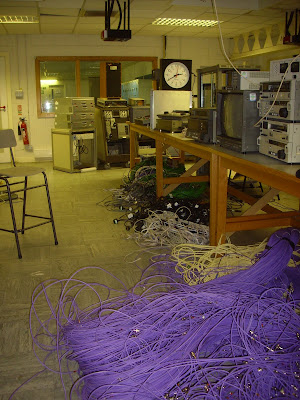Last weekend we visited Coopers Technology College to give the producers of Talent Showdown a hand with the rig of their flyaway. Unfortunately we ran into a few technical hitches, notably due to a couple of unknown flaws in the rig of the sync. The initial system diagram (drawn by George Alton) can be seen below.
During the run up to the show there were minor flaws, mostly due to dodgy cable ends meaning that colour information kept being dropped in a couple of the camera outputs. Eventually we also realised that several of the cameras were losing their colour when they were run through the main programme bank of the vision mixer. After an hour or so of tweaking we couldn't find a solution and seeing as the preview outputs weren't losing their colour information we decided that it was something to do with the main programme bank. As a work around we then took the PVW output and ran this into a VDA and thus distributed it to the VTR's and the monitors.
Once the programme started we then ran into more problems, after the first five minutes a couple of the cameras kept dropping their sync during a cut from the vision mixer. This eventually got worse until they were not genlocking at all. The only feasible solution was to put tapes into all of the cameras and iso record them, all we had to do was sync up the timecode between the cameras to make it easier during the edit. We also recorded the camera that we were originally going to use as a back-up onto a VT Deck so that production would have plenty of options when it came to the final edit
After the shoot we realised that part of the reason that some of the cameras may have been losing their sync was because when shooting with composite video you have to be incredibly careful with timing, far more careful than we had been. Originally we ran the Black & Burst into a DA and distributed it across all of the equipment, what we apparently should have done is run a feed of BB into the vision mixer, then taking a separate assigned output of BB for each of the inputs and run these into the cameras, then taken the final BB o/p of the mixer into a DA and distributed that accordingly. We still need to verify that this is the case but at the moment that appears to be the thing that went wrong, however it doesn't explain why the timing was pretty much fine all morning!
At the end of the day we all managed to find a suitable work-around, it does mean that the post production team have a little more work to do and hopefully the footage doesn't turn out to be that bad.
Once the programme started we then ran into more problems, after the first five minutes a couple of the cameras kept dropping their sync during a cut from the vision mixer. This eventually got worse until they were not genlocking at all. The only feasible solution was to put tapes into all of the cameras and iso record them, all we had to do was sync up the timecode between the cameras to make it easier during the edit. We also recorded the camera that we were originally going to use as a back-up onto a VT Deck so that production would have plenty of options when it came to the final edit
After the shoot we realised that part of the reason that some of the cameras may have been losing their sync was because when shooting with composite video you have to be incredibly careful with timing, far more careful than we had been. Originally we ran the Black & Burst into a DA and distributed it across all of the equipment, what we apparently should have done is run a feed of BB into the vision mixer, then taking a separate assigned output of BB for each of the inputs and run these into the cameras, then taken the final BB o/p of the mixer into a DA and distributed that accordingly. We still need to verify that this is the case but at the moment that appears to be the thing that went wrong, however it doesn't explain why the timing was pretty much fine all morning!
At the end of the day we all managed to find a suitable work-around, it does mean that the post production team have a little more work to do and hopefully the footage doesn't turn out to be that bad.







